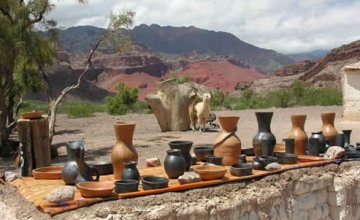Away from the urban centers, a special attraction for lovers of good wine and for those who like to learn a little bit more about winemaking and savor wine bouquets.
While visiting the
Calchaquí Valleys and as part of the
Wine Route, we resolved to pass by Colomé Winery, famous for its high vineyards -lying at 2,300 meters of height- and for the experience and dedication with which wine is made at this venue. We telephoned the manager, Mrs. Gloria Diez Peña, who gave us the information we needed to reach the winery. She suggested that we should travel without haste in order to enjoy the surroundings, which undoubtedly were part of the tour.
Cafayate was our starting point. We left the city willing to face the gravel roads, as the place we were headed to was quite promising. Following Route 40 in the direction of Molinos, after a four hours’ drive that unveiled a unique landscape with small villages that seemed to hang from the mountains, we came close to our destination guided by the road signs.
Official Presentation We spotted the winery and its accommodation facilities from a distance. These buildings stood out due to their colonial style. Gloria met us at the gate and led us to the site where guided tours start. She introduced us to our host: Pedro Aquino. The visit to the winery began with a video that showed us a brief account of the history of the winery, the care for the vineyards, the harvest and the process to make different varieties of wine. We learned that the first
malbec and
cabernet sauvignon grapes were brought along from France in 1854, though the winery had already been built by then. The entire winemaking process, from the night harvest in the Cafayate, Payogasta and Colomé vineyards up to the shipping of bottled wine, is very neat. During the harvest, trucks loaded with grapes arrive in the venue very early in the morning to avoid high temperatures. At the classification tables, about fifteen workers select the grapes by hand and divide them according to the variety they represent. We saw the fermentation tanks, where the liquid resulting from the crushing of the grapes is put. It stays there for the period stipulated by experts according to each grape type and depending on whether they come from old or new vineyards. Phenols, tannins and antioxidants rule at this stage, as they are shaken several times a day.
Lab workers and enologists constantly check on the process in order to manage top quality for each of the varieties. No agrochemical products, fungicides or fertilizers are used. Everything is natural, as a result of the type of soil: hard, dry and high. Touching Wood As we asked, Pedro told us that “the oak casks are used only once. In some cases, it is necessary to put the wine into new casks up to three times, depending on how long the wine is supposed to be aged in them. Otherwise, the quality and taste of the wine would be contaminated by the contact with the wood of one cask if it remains in it longer than necessary”. We were deeply touched to see a vast vineyard through the large windows in the dining-room. It lay just a few steps away from the building. It was a living museum, the first vineyards of the winery, which date back to a hundred and fifty years ago. Future enologists or wine lovers take courses at Colomé and it is in this place where they compare the stems, leaves and fruit of each grape variety as part of the learning process. Colomé Winery is well-known for its wines managed with ancient European grapes combined with cutting-edge technical advanced programs used from the fermentation stage through the moment of bottling. Grape Nectar on Our Palate It was time to taste the wine varieties, test their body, color, brightness and power. Sitting at the bar and with very tall glasses before us, we took part in a tasting session. We were offered malbec estate, amalaya and torrontés. We learned about the composition or percentage of cabernet, malbec, and tannat grapes present in each variety. Likewise, we found out that the product quality must be constant year after year. That will depend on the work done by the enologists to vary maceration times and storage in casks or bottles. The result of such a demanding process is also fruitful. International entities have awarded vintages from the last three years with very high scoring. The enologists at the winery feel very proud indeed. All the wines are headed for specialized wine stores, both in Argentina and abroad. Thus, their features are intact when they get to the table of connoisseurs. We Promised to Return We said good-bye to Pedro and, escorted by Gloria, we saw other areas in the venue. Outdoors again, we enjoyed the green undulations around the facilities until we reached Estancia Colomé hotel. Situated within a perfect frame, where nature joins excellent service, it seems to be the ideal site to relax and spend vacations away from urban centers. We had a look at the neat crops and the area where animals are raised. They supply the hotel following byodinamic production procedures. Other alternatives to enjoy free time are activities proposed at the venue, such as horse riding, swimming, cycling, playing tennis, etc. Artist James Turrell’s museum contributes to the achievements by the owners of the venue: Mr. Donald and Úrsula Hess. The afternoon came to an end with 6,000-meter-high Cachi snow-capped mountain range in the background. We retraced our steps away from this beautiful nook, making sure we did not leave too suddenly. Mónica Pons
Eduardo Epifanio
Phone: +54 3868-494200








































